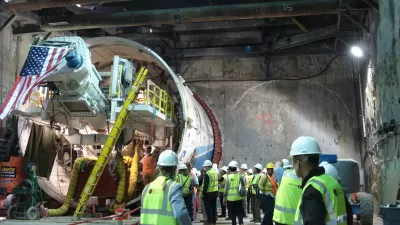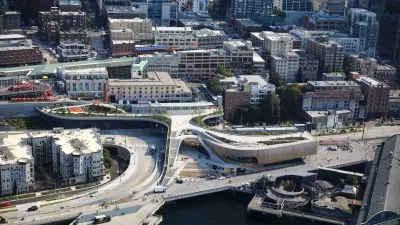At the heart of the financial and deadline challenges facing the $68 billion high-speed rail project are 36 miles of tunneling north of Los Angeles, according to Los Angeles Times analysis that includes interviews with experts on mega-projects.

"State officials say the tunnels will be finished by 2022 — along with 300 miles of track, dozens of bridges or viaducts, high-voltage electrical systems, a maintenance plant and as many as six stations," writes Ralph Vartabedian of the Los Angeles Times.
Vartabedian writes that his paper's analysis "indicates that the deadline and budget targets will almost certainly be missed — and that the state has underestimated the challenges ahead, particularly completing the tunneling on time." which he calls "the most ambitious tunneling project in the nation's history."
"It doesn't strike me as realistic," said James Monsees, one of the world's top tunneling experts and an author of the federal manual on highway tunneling. "[Earthquake] Faults are notorious for causing trouble."
The tunnel challenges are indeed formidable. The project "will require about 20 miles of tunnels under the San Gabriel Mountains between Burbank and Palmdale, involving either a single tunnel of 13.8 miles or a series of shorter tunnels."
The rail authority only asked permission last month to begin testing under the Angeles National Forest to build the tunnels, wrote Steve Scauzillo of the San Gabriel Valley Tribune on Sept. 25 in a detailed article about tunnel options.
In addition, "(a)s many as 16 additional miles of tunnels would stretch under the Tehachapi Mountains from Palmdale to Bakersfield," adds Vartabedian.
Three years ago Vartabedian wrote about the same engineering challenges - posted here.
Other experts chimed in on the other challenges facing nation's largest public works project.
...Bent Flyvbjerg, a University of Oxford business professor and a leading expert on megaproject risk, said the lagging schedule, litigation, growing costs and permit delays arising so early in construction are warning signs that even more delays and higher costs are coming.
"You can never make up an early cost increase," said Robert Bea, a member of the National Academy of Engineering and a pioneer in civil engineering risk analysis. "It just gets worse. I have never seen it go the other way in 60 years."
Do tunnel projects go bad? Just ask the citizens of Seattle where the world's largest boring machine, Big Bertha, has yet to renew boring the Alaskan Way Viaduct replacement tunnel since it broke down in December 2013. However, it was "on the move" last February and is now being repaired.
Notwithstanding the projects formidable challenges, there are those who believe in the project, wrote Steve Benen for MSNBC in January. Even retiring House Speaker John Boehner said rather unexpectedly two years ago that he’d like to see the United States become “a nation of builders” again.
FULL STORY: Special Report $68-billion California bullet train project likely to overshoot budget and deadline targets

Study: Maui’s Plan to Convert Vacation Rentals to Long-Term Housing Could Cause Nearly $1 Billion Economic Loss
The plan would reduce visitor accommodation by 25,% resulting in 1,900 jobs lost.

North Texas Transit Leaders Tout Benefits of TOD for Growing Region
At a summit focused on transit-oriented development, policymakers discussed how North Texas’ expanded light rail system can serve as a tool for economic growth.

Why Should We Subsidize Public Transportation?
Many public transit agencies face financial stress due to rising costs, declining fare revenue, and declining subsidies. Transit advocates must provide a strong business case for increasing public transit funding.

How to Make US Trains Faster
Changes to boarding platforms and a switch to electric trains could improve U.S. passenger rail service without the added cost of high-speed rail.

Columbia’s Revitalized ‘Loop’ Is a Hub for Local Entrepreneurs
A focus on small businesses is helping a commercial corridor in Columbia, Missouri thrive.

Invasive Insect Threatens Minnesota’s Ash Forests
The Emerald Ash Borer is a rapidly spreading invasive pest threatening Minnesota’s ash trees, and homeowners are encouraged to plant diverse replacement species, avoid moving ash firewood, and monitor for signs of infestation.
Urban Design for Planners 1: Software Tools
This six-course series explores essential urban design concepts using open source software and equips planners with the tools they need to participate fully in the urban design process.
Planning for Universal Design
Learn the tools for implementing Universal Design in planning regulations.
City of Santa Clarita
Ascent Environmental
Institute for Housing and Urban Development Studies (IHS)
City of Grandview
Harvard GSD Executive Education
Toledo-Lucas County Plan Commissions
Salt Lake City
NYU Wagner Graduate School of Public Service




























